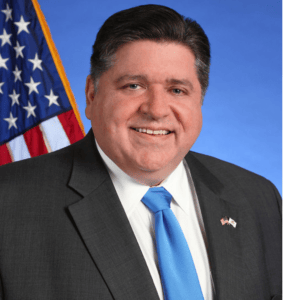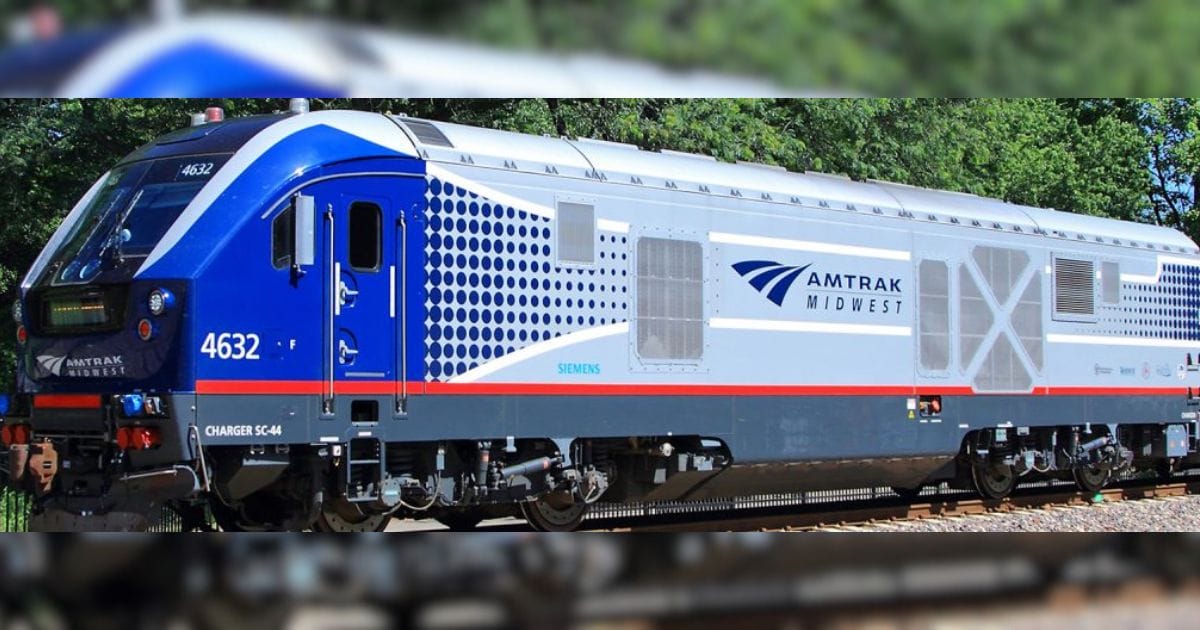Safety, reliability, and accessibility upgrades completed on route, made possible by $1.96 billion in funding

Governor JB Pritzker joined federal, state, and local officials, along with the Federal Railroad Administration, Amtrak, the Union Pacific Railroad, and project supporters at Union Station today to celebrate the start of 110 mph passenger rail service between Chicago and St. Louis. This multi-year project better connects the state’s communities and major institutions while improving safety, convenience, and accessibility. Starting with the first trains on Amtrak’s state-supported Lincoln Service this morning, the higher speeds are eliminating approximately 15 minutes from the previous 90 mph runtimes between the two cities and 30 minutes from the initial 79 mph schedule in place when the project broke ground.
“Illinois is the only state where all seven of the nation’s largest railroads operate. That’s a unique economic advantage recognized by employers across the globe, helping our state attract and maintain quality jobs,” said Governor JB Pritzker. “By upgrading to higher-speed service on Illinois’ largest passenger rail line, we are solidifying our status as the transportation hub of North America. Investments like these do more than just connect cities – they allow our residents to access opportunities beyond their immediate neighborhoods, streamline regional collaborations, and open doors for new jobs and new businesses.”
“I’m proud to join our state and local leaders to celebrate the new Lincoln Line, a defining moment that will take our state’s transportation to the next level,” said Lt. Governor Juliana Stratton. “This high-speed passenger rail service is an investment that will strengthen our local economy, connect Chicago and St. Louis residents, and drive Illinois forward with safe and reliable transportation at the forefront of our efforts.”
In addition to increasing speeds, the $1.96 billion project has boosted safety and reliability for passengers while providing upgraded and new stations. Ride quality has also been enhanced up and down the corridor for both passenger and freight service on the Union Pacific Railroad, thanks to the addition of new concrete ties along the route and improvements to bridges, culverts, and signaling systems.
Major upgrades were performed at 212 grade crossings by installing four-quadrant gates and loop detectors to help prevent collisions with vehicles on the tracks. Pedestrian gates and fencing were built to protect people crossing tracks passing through towns and neighborhoods. Thirty-nine crossings deemed at-risk were permanently closed.
The project also built new stations in Dwight, Pontiac, Carlinville, and Alton, renovated the Lincoln station, improved the existing Normal station, and made upgrades to the Springfield station. A separate project to build a new multimodal station in Joliet was completed in 2018, with a second phase starting in 2021.
The facilities provide a better customer experience and amenities, such as free Wi-Fi and connections to bicycle and pedestrian facilities. The new and improved stations act as gateways to their communities, inviting tourism and providing additional travel options for the public.
A final component of the project is the acquisition of new locomotives and railcars to be used throughout the Midwest. The new Charger locomotives are the first higher-speed passenger locomotives to meet Tier 4 emissions standards, resulting in 90% emissions reduction compared to older locomotives. Thirty-three new locomotives have been in service since late 2017.
Illinois is also part of a consortium of states working to procure 88 new single-level railcars that are fully accessible for persons with disabilities for use in Illinois, Missouri, Wisconsin, and Michigan. More than 50 of the cars are currently in revenue service on Amtrak Midwest routes.
“The Chicago to St. Louis high-speed rail project is testament to the power of collaboration, innovation, and a shared vision for a brighter future,” said U.S. Senator Dick Durbin (D-IL). “This transformative endeavor, decades in the making, symbolizes our commitment to improving mobility, creating jobs, and fostering sustainable growth. From local communities to federal officials, countless individuals have contributed to its success, leaving an indelible mark on the Midwest and our nation’s rail operations. As we witness the realization of our long-term aspirations, let us embrace this moment as proof to what we can accomplish when we unite for progress and invest in the future of transportation. Today, we celebrate not just a railway, but a symbol of possibility, prosperity, and a more connected future for all.”
“Modernizing our rail services means faster travel times and access to safer, more reliable service,” said U.S. Senator Tammy Duckworth. “The Lincoln Service line is a critical element of our state’s transportation network, and I’m so pleased to see the results of critical federal funding to improve the lives and travel options for Illinoisans.”
“The achievement of reaching 110 mph on the Lincoln Service line is another step in creating more efficient, safe, and environmentally friendly ways for Americans to travel,” said U.S. Representative Mike Quigley. “It also furthers Chicago’s position as a major hub within our nation’s transportation system. I will continue to push for federal investment in highspeed rail to see more projects like this come to fruition.”
“I’m thrilled to see the completion of the upgraded Lincoln Service line, which is a testament to what can be achieved through state and federal collaboration,” said Congressman Bill Foster (D-Naperville). “This upgrade will help build a safer, more efficient and reliable transit system, spurring economic growth for communities large and small across Illinois. I look forward to continue working with my colleagues to ensure Illinois remains a leader in infrastructure innovation.”
“The team at IDOT, Amtrak, and UP has delivered travel times that will make a real difference to our customers: Less than two hours from Chicago to Bloomington-Normal and shorter than three hours to Springfield, with end-to-end St. Louis-Chicago schedules of under five hours,” said Amtrak President Roger Harris. “Between the shorter schedules and having more than half of all the new state-owned Amtrak Midwest ‘Venture’ railcars now in service, we are completing a full makeover of this corridor service. We thank Gov. Pritzker and the entire Illinois congressional delegation for their leadership and support.”
“Union Pacific is proud to have been a part of this large-scale, multiyear undertaking to safely accommodate both freight and high-speed passenger trains on the same rail line,” said Union Pacific Chairman, President, and CEO Lance Fritz. “This project embodies the true meaning of partnership and underscores what can be accomplished when we come together and pull in the same direction.”
“The Federal Railroad Administration is proud to support the Chicago-St. Louis corridor, which provides needed passenger rail services to over 13 million residents in numerous communities,” said FRA Deputy Administrator Jennifer Mitchell. “The more than $1.3 billion that FRA has contributed to corridor improvements has allowed for increased trains speeds, upgraded safety systems, and accessible passenger rail stations and cars that will transform the passenger experience for riders in this diverse and economically vital region. With the Bipartisan Infrastructure Law making the largest investment in passenger rail since the creation of Amtrak, we look forward to funding even more improvements in the Midwest and across the country.”
“SMART-TD is a proud advocate for improved and increased passenger rail service and has worked hard with other important stakeholders to get to where we’re at today, new 110 MPH service,” said Robert W. Guy, State Director, Illinois Legislative Board, SMART-Transportation Division. “The reduction in travel times on the Lincoln Service will help drive another surge in ridership, much like what we saw in the mid-2000’s when Illinois doubled service statewide. Investing in passenger rail is a proven job creator and addresses an obvious public appetite for expanded service across Illinois and the Midwest.”
The project is made possible via $1.66 billion in federal funding, primarily through an American Recovery and Reinvestment Act grant, as well as $300 million in state and non-federal funds. The project broke ground in 2010 with major infrastructure improvements completed in 2018. From 2019 to 2023, IDOT has worked with project partners to install and test a Positive Train Control system that allows passenger trains to increase their speed first to 90 mph and now 110 mph while enabling technology to automatically stop a train before a collision.
“Under Gov. Pritzker, IDOT is delivering one of the more complex projects in our history, requiring an unprecedented level of teamwork among the state and railroads, as well as our federal and local partners,” said Illinois Transportation Secretary Omer Osman. “The progress continues. Thanks to the governor’s historic Rebuild Illinois capital program, we will be advancing freight and passenger rail improvements throughout the state in the years ahead.”
For additional information on the new schedule or to purchase tickets, visit amtrak.com/midwest.






